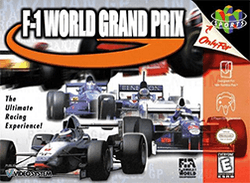F-1 World Grand Prix
| F-1 World Grand Prix | |
|---|---|
|
North American Nintendo 64 cover art | |
| Developer(s) |
Paradigm Entertainment, Video System, Lankhor |
| Publisher(s) |
Nintendo 64 Dreamcast
PlayStation
Windows |
| Director(s) | Wes Hoffman |
| Composer(s) | Dan Hess |
| Series | F-1 Grand Prix |
| Platform(s) | Nintendo 64, Dreamcast, PlayStation, Game Boy Color, Windows |
| Release date(s) |
Nintendo 64
Dreamcast PlayStation Game Boy Color Windows |
| Genre(s) | Sim racing |
| Mode(s) | Single-player, multiplayer |
F-1 World Grand Prix is a Formula One racing game/sim first released in 1998 for the Nintendo 64 game console and to later platforms including the Sega Dreamcast, Game Boy Color, PC and Sony PlayStation. It is based on the 1997 Formula One season, featuring each of the 17 circuits from the season and all 22 drivers (as well as two unlockable bonus racers), with the exceptions of Jacques Villeneuve (licensing reason) and the MasterCard Lola team (not recognised, as they did not take part in any races during the season).
Gameplay
The game consists of five gameplay modes: Grand Prix, a course-by-course simulation of the 1997 season; Exhibition, a single race; Time Trial, a race against the clock and Challenge, which comprised real scenarios from the 1997 season-examples include trying to win the 1997 Hungarian Grand Prix as Damon Hill or beating Jean Alesi as David Coulthard in the 1997 Italian Grand Prix. The final mode allowed 2 players to compete in a single, split-screen race.
F-1 World Grand Prix offered a fairly realistic experience for its time. Prior to races, allowed for the fine-tuning of the player's car; including tyre tread, amount of fuel and wing angle. The cars themselves followed realistic simulated physics and were at risk of damage and wear like their real-life counterparts. Weather (and its effects) was also simulated. Visually, the game offered the same trademark appearance of live F1 coverage, and aimed to have a photo-realistic appeal.
F-1 World Grand Prix was highly acclaimed by most critics, more so than its sequel F-1 World Grand Prix II, which many felt lacked a sufficient number of improvements over the original.
Due to copyright issues, Williams F1 driver Jacques Villeneuve is not featured in the game and in his place is a silhouette of his body and his name is simply Driver Williams. However, his career statistics are correct. This character's name could be customized by the player, either to personalise their driver or to unlock certain extras, such as the Silver and Gold racers, as well as a fictional Hawaiian circuit.
Reception
| Reception | ||||||||||||||
|---|---|---|---|---|---|---|---|---|---|---|---|---|---|---|
| ||||||||||||||
On release, Famitsu magazine scored the Sega Dreamcast version of the game a 30 out of 40.[5] N64 Magazine's James Ashton said that the game is "the finest driving simulation the world has ever seen."[6]
References
- ↑ "F-1 World Grand Prix for Nintendo 64". GameRankings. Retrieved February 5, 2016.
- ↑ "F-1 World Grand Prix for PlayStation". GameRankings. Retrieved February 5, 2016.
- ↑ "F-1 World Grand Prix for Dreamcast". GameRankings. Retrieved February 5, 2016.
- ↑ "F-1 World Grand Prix for PC". GameRankings. Retrieved February 5, 2016.
- 1 2 ドリームキャスト – F1 WORLD GRAND PRIX for Dreamcast. Weekly Famitsu. No.915 Pt.2. Pg.50. 30 June 2006.
- 1 2 Ashton, James (October 1998). "F-1 World Grand Prix". N64 Magazine (20): 62–67.

